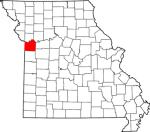|
Welcome to Jackson County Missouri
Genealogy Research
History
In
The Beginning: 1826-1850
Jackson County
Log Courthouse
The oldest relic of County
government is the first courthouse
of Jackson County, which is
preserved to this day. The log
structure, intended to be only a
temporary courthouse, was erected on
a private lot because the public
square was being reserved for a more
prestigious building.
The 1827 Jackson
County Log Courthouse near
Independence Square, Independence,
Missouri, is the handiwork of Samuel
Shepard, African-American slave of
James Shepherd (note the difference
in spelling). Shepherd settled with
his family near the public spring on
the east side of the original plat
of Independence.
Building the
Courthouse
The contract for the first County
courthouse was awarded to Daniel P.
Lewis, through competitive bidding,
for $150. After nine years, this log
courthouse was abandoned by the
County Court for more permanent
quarters in the center of
Independence Square. Lot 59, where
the log courthouse stood, was sold
to private interests. The lot
changed hands several times, and the
log courthouse had many different
uses over the years.

By the time Independence Mayor Christian Ott
Jr., became the log courthouse's owner, he
offered the structure to the City of
Independence for preservation. But after
several years, the City had made no
arrangements to find another site for its
removal. Then, in 1916, Ott offered it to
Jackson County. The County Court, with Mayor
Ott’s concurrence, offered the building to the
Kansas City Board of Parks Commissioners who
consented to move it to Swope Park. Within two
days of this offer, the City of Independence
quickly passed an ordinance on October 24,
1916, authorizing the removal of the building
to a vacant lot just west of the Independence
City Hall (202 S Main), where the Log
Courthouse is today (107 W Kansas).
Jackson County Court
Prior to the adoption of the current County
Charter in 1970, the governing body in Jackson
County, Missouri, was called the Jackson
County Court, our form of County government
that dates back to Jackson County’s formation
on December 15, 1826.
The County Court consisted of a legislative
panel of three individuals popularly elected.
Each one had the title of “County Judge,”
which is like a county commissioner common in
other areas of the country. Some Missouri
counties are still governed by county courts.
County Representation
Jackson County was divided into halves for
representation purposes with no regard to
population. The County Judge for the Western
District represented Jackson County interests
in the western part of the County, including
Kansas City. The County Judge for the Eastern
District represented Jackson County citizens
in the eastern half of the County.
The third elected position - “Presiding Judge”
- led the legislative body and helped make
difficult decisions, especially when the other
2 judges were divided and split their votes.
This position is similar to the County
Executive elected today.
Independence in
1832
Washington Irving and friend Charles Joseph
Latrobe, spent a few days in Independence in
the Autumn of 1832. Irving wrote:
“We arrived at this place [Independence,
September 24, 1832] the day before yesterday,
after nine days’ traveling on horseback from
Saint Louis. Our journey has been a very
interesting one, leading on across fine
prairies and through noble forests, dotted
here and there by farms and log-houses, at
which we find rough but wholesome and abundant
fare and very civil treatment. Many parts of
these prairies of Missouri are extremely
beautiful, resembling cultivated countries,
rather than the savage rudeness of the
wilderness.
“Yesterday I was out on a deer hunt in the
vicinity of this place, which led me through
some scenery that only wanted a castle, or a
gentleman’s seat here and there interspersed,
to have equaled some of the most celebrated
park scenery of England.
“The fertile of all this Western country is
truly remarkable. The soil is like that of a
garden, and the luxuriance and beauty of the
forests exceed any I have seen. We have
gradually been advancing, however, toward
rougher and rougher life, and are now at a
straggling little frontier village that has
only been five years in existence. From hence,
in the course of a day or two, we take our
departure southwardly, and shall soon bid
adieu to civilization [the edge of the United
States was at State Line until 1854] and
encamp at night in our tents. My health is
good, though I have been much affected by the
change in climate, diet and water since my
arrival in the West. Horse exercise, however,
always agrees with me. I enjoy my journey
exceedingly and look for still greater
gratification in the part which is now before
me, which will present much greater wildness
and novelty. The climax will be our expedition
with the Osages to their hunting grounds and
the sight of a buffalo hunt.”
1836 County Courthouse
In 1836, the first permanent, brick Jackson
County Courthouse was erected on Independence
Square, the County Seat for Jackson County.
Believe it or not, this 1836 structure is
entombed in the current building! For specific
details about the construction and evolution
of Jackson County’s Courthouses, contact the Jackson County Historical
Society. Inquire about their journal
articles about this fascinating topic.
Adding to the Courthouse
A tall, pointed spire was added to the 1836
Jackson County Courthouse in 1846. It was
visible for miles around in those days (given
that Independence Square is on high ground and
at that time few trees obstructed views and
vistas).
The Donner Party
In April 1846, a 250-wagon train outfitted at
mercantile stores and blacksmith shops around
Independence Square. The Donner party was
among the emigration heading west that spring.
As the wagon train traveled westward it began
to break up into smaller units. Some emigrants
wanted to travel at a different pace; others
wanted to take different routes (or cut-offs).
The Donner party’s fate is a well-documented
tragedy. Another family in the wagon train,
the Campbells from Saline County, Missouri,
and Muhlenberg County, Kentucky, were among
those who chose a safer route and travel speed
and made it to their destination. Most of the
Campbells went the California route, but one
family struck out for rich land in Oregon.
Gold Rush
After gold was discovered in 1848 at one
former Jackson Countian’s California stake
(John Sutter of Westport), a rush for riches
ensued. A flood of young men passed through
Jackson County on their way to strike it rich
in the spring of 1849. The following year, an
even larger emigration funneled through our
area towards the territory of California
(emigrants of 1850 arrived at California’s
doorstep just as California was admitted to
the Union that September). Nephews of the
Campbells, who had left Independence in 1846,
were among this migration, which has been
called the largest, voluntary, overland
migration in United States history.
Find out more about this original American
story with tremendous significance to Jackson
County in the nonfiction book Direct Your
Letters to San Jose available in the Jackson
County Historical Society’s archives.
Mexican War veterans returning from the
Southwest in 1848 found the Jackson County
Courthouse enlarged, its exterior walls
refaced and the building garbed in a form of
colonial architecture. It was this courthouse
that the multitudes of Oregon and California
emigrants would see as they outfitted for
their long, arduous journey into the West.
|
©
JenkinsGenealogyResearch All Rights
Reserved.
This site last updated:
|



